O MAGNUM MYSTERIUM
Morten Lauridsen
Quick Facts:
Born: 1943, Colfax, Washington, U.S.
Composed: 1994
Premiere: December 18, 1994 by Los Angeles Master Chorale, conducted by Paul Salamunovich
Length: 6 minutes
Born in 1943, Lauridsen has been a teacher at the Thornton School of Music at the University of Southern California since 1967. In 2006, Lauridsen was named an 'American Choral Master' by the National Endowment for the Arts. In 2007 he received the National Medal of Arts from the President in a White House ceremony, "for his composition of radiant choral works combining musical beauty, power and spiritual depth that have thrilled audiences worldwide."
When the Los Angeles Master Chorale commissioned Morten Lauridsen’s setting of “O Magnum Mysterium” in 1994, few people anticipated that it would elevate the composer’s career as it did. It was at that very first concert that music director Paul Salamunovich told the audience, “Until now, Vittoria’s O Magnum Mysterium has been the most beautiful and well recognized setting of this text composed to date. I predict that will change after tonight.”
Inspired by a 1633 painting, Still Life with Lemons, Oranges and a Rose by Francisco de Zurbarán, Lauridsen wrote in the Wall Street Journal (2/21/2009):
"...the objects in this work are symbolic offerings to the Virgin Mary. Her love, purity and chastity are signified by the rose and the cup of water. The lemons are an Easter fruit that, along with the oranges with blossoms, indicate renewed life. The table is a symbolic altar."
It is a setting of the responsorial chant from the service of Matins on Christmas day, which describes the ‘great mystery’ of the work’s title where the animals see the newborn Lord lying in a manger.
The composer said he wanted to be simple and direct in the music, and was inspired by Palestrina and other early Renaissance composers. The melodies come out of chant, and he uses primary chords (I, IV, and V) for the most part, sometimes in first inversion, and with parallel triads.
Lauridsen worked on the piece for six months, at his home on Waldron Island, Washington. He said that the work is meant as "a quiet song of profound inner joy", with music expressing both the mystery of the Incarnation and Mary's tenderness for her child. His biggest challenge, he says, was how to represent the sorrow of Mary, knowing her son would be killed. Inspiration hit him one night and, in his words, the “most important note in the piece - G# - is used on the word virgo.” It is the only note outside of the key (D Major) and needs resolution, which he does, into a minor triad. Lauridsen says “it shines a sonic spotlight on the importance of that word (virgin).”
Lauridsen program notes by Patricia Anderson
O Magnum Mysterium Text:
Latin Text:
O magnum mysterium,
et admirabile sacramentum,
ut animalia viderent Dominum natum,
iacentem in praesepio!
O beata virgo, cuius viscera
meruerunt portare
Dominum lesum Christum.
Alleluia!
English Translation:
O great mystery,
and wonderful sacrament,
that animals should see the newborn Lord,
lying in a manger!
Blessed is the virgin whose womb
was worthy to bear
the Lord, Jesus Christ.
Alleluia!









